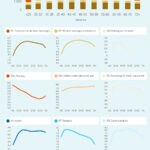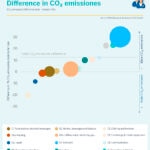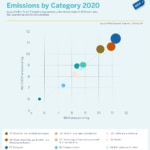Adults between 35 and 40 years of age emit 10 percent more CO2 than the average, according to BBVA Research
Spanish households with higher consumption emit more CO2 than those with lower expenditure, although this difference is accentuated by transport use patterns, while emissions from food and energy are less unevenly distributed. By age, adults aged between 35 and 40 emit 6.9 tons of CO2 per year on average, 10% more than the average Spanish adult, according to the report ‘The Carbon Footprint of Spanish Households’ by BBVA Research.

Emissions from energy services tend to increase with the age of the consumer, while those from transportation have an inverted "U" shape with a maximum in the 35-40 age range. These results are the consequence of different consumption patterns, influenced by factors such as income level or lifestyle.
In the case of those aged 70 and over, there is a reduction in their carbon footprint of around 27% compared to the average. Younger individuals (under 25 years old) emit between 10 and 18 percent less CO2 than the middle-aged group (30-40 years old).
In summary, a 22% increase in CO2 emissions can be seen during the life cycle from young adulthood to middle age, followed by a similar decrease in consumption in old age.
According to the report, emissions linked to transportation and luxury goods and services show significant inequality, while CO2 emissions from Spanish households from housing and energy services show a much less unequal distribution.
Overall, the BBVA Research study sheds light on the evolution of the carbon footprint in different age groups and for the main consumption categories.

These findings highlight the importance of considering differences in consumption typology, age and income when drafting emission mitigation policies, especially those related to products with more unequal distribution, such as transportation.
Gender inequality is also observed in the CO2 emissions footprint. Men's consumption is on average 12% more polluting due to the greater weight of spending on transport, which is also more emissions-intensive, according to BBVA Research.
Women have a larger carbon footprint in products consumed in the health sector (10% more than men) or in clothing and footwear (20% more than men). Men's consumption has a larger carbon footprint in education, communication, and culture, according to data collected and analyzed by BBVA Research.
As for the consumption of alcoholic and non-alcoholic beverages, tobacco, and housing, a more or less balanced carbon footprint can be seen in the consumption of alcoholic and non-alcoholic beverages by both sexes. The same is true for the consumption of services such as water, gas and electricity, among others.
Of particular relevance to the issue of gender inequality, however, is the fact that the available data attribute the expenditure to the person making the payment. This person does not necessarily have to be the one who actually enjoys the expenditure, as in the case of education, health, entertainment, and culture, for example.

The degree of inequality increases significantly from the 80th percentile of the consumption level. The top 10% of this percentile is responsible for almost 24% of CO2 emissions, while the bottom 50% accounts for 29% of emissions.
The BBVA Research study distinguishes between direct and indirect emissions, the sum of which represents the total footprint of consumption emissions.
- Direct emissions are those resulting from combustion in the home, for example for heating, and from the use of private vehicles.
- Indirect emissions are those that are not made directly by the individual, but which are necessary in the production processes of the goods and services enjoyed by the individual. These emissions come from a variety of sources, such as the manufacture of a T-shirt, food consumed in a restaurant, household cleaning products or the manufacturing process of a car, among others.
BBVA Research estimates indicate that indirect CO2 emissions account for nearly 70% of total emissions.
Detailed analysis of the greenhouse gas footprint also makes it possible to distinguish a variety of greenhouse gases in real time. This provides a useful tool for the evaluation of impacts and public policies to mitigate emissions.
Consumption patterns are, according to the report, key to mitigating climate change. By consuming more sustainably, individuals can help reduce the negative impact of their actions on the environment and support the transition to a more sustainable future.
The high granularity of CO2 emissions distribution data opens the door to designing systems with more targeted policies, i.e., increasing their effectiveness and applying them in places where their presence and use is required.
In its report, BBVA Research stresses that the Earth's climate is changing rapidly as a result of human activities. The latest IPCC report concludes that the increase in the concentration of greenhouse gases in the atmosphere causing global warming (1.1ºC higher than the average for the period 1850-1900) is caused by emissions from human activities. This leads to increasingly frequent and severe adverse weather events, with loss of human life and nature-related damage.
The analysis presented by BBVA Research combines the standard Input-Output methodology with a massive database (Big Data) of consumer transactions, conveniently anonymized and scaled to the structure of the Spanish economy.
